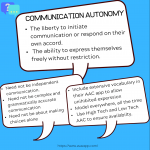Every Child Can Read and Write : AAC and Literacy

We believe, as a matter of faith, that one of the end-points of AAC(Augmentative and Alternative Communication) is the development of literacy, i.e. the ability for a non-verbal child to read and write.
Well-designed AAC is more than an assistive technology — it is also an educational technology. In other words, AAC can (and should) provide a way for a child to transition from being a picture-user to being a text-user.
Some parents, and even a few therapists, sometimes question the assumption that a non-verbal child is capable of literacy. We take inspiration from David Yoder’s quote — “no child is too anything to be able to read and write”. Both systematic research as well as anecdotal evidence has shown that even children with very high levels of disability can be taught literacy.
Teaching literacy is very important, because it is the gateway to education and employment; and is the key to inclusion.
Subscribe to the Avaz Newsletter
Join 4000+ fellow readers! Get latest articles straight to your inbox. Enter your email address below:
For some reason, people think a child should start learning to read and write only after they have learnt to speak and listen. It is true that for most children who are typically developing, speech develops at the age of around 2, maybe 3. And they begin to read and write when they are 4, maybe 5 — in kindergarten. However, this staging is not so much a function of language capability as it is of, maybe, motor capability and other mental and physical functions. In other words, there are so many things happening simultaneously as the brain of a typically developing child develops, that it seems incorrect to say that the ability to read and write is somehow dependent on the ability to talk.
In the case of children with special needs, the situation is completely different. Some kids with autism spectrum disorders only get formally diagnosed when they are entering kindergarten — at 4 or 5. And this is the age at which AAC intervention may begin. It’s important for us to assume — whether it’s true or not — that at this age, the child is capable of learning to communicate both in-conversation (speaking/listening) but also offline (reading/writing). At an age when typically developing children are being taught literacy, it is important that children with special needs are also taught the same thing.
We have no data to indicate that this would be an overload for them in any way — in fact, all data indicates the opposite, which is that they can achieve functional literacy faster and at a higher level than their caregivers often think.
That’s why literacy education is a critical part of communication and language development. And because AAC is the most pervasive tool that we use for communication training, it is very important to find ways to incorporate AAC into literacy training, too.
What do you think? Let us know your comments below.
Popular Articles
- Building Literacy: Teaching Grammar to AAC Users
- Expansion of Language: Supporting AAC Learner’s Progress
- Avaz User Stories and Videos
- Avaz Joyful Reading: Resources for Shared Reading
- AAC Resources: Games, Activities and Communication Opportunities
- Avaz AAC User Stories: Why Nishant and his AAC System are Inseparable
- Downloadable Low Tech Communication Boards
- Get the Better of Reading Difficulties with MDA Avaz Reader
- AAC Apps for Adults with Acquired Communication Disorders
- Teletherapy: A smart way to facilitate remote speech therapy for adults and children
